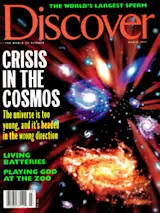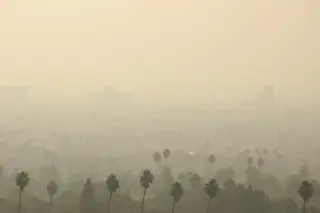These are proud times for atmospheric chemists. This year is the last year that American industry will produce chlorofluorocarbons, the ozone-destroying compounds used in such things as refrigerators and insulation. The 130-nation agreement that led to the banning of CFCs, an extension of the Montreal Protocol of 1987, was triggered by the persuasive research of atmospheric chemists. Over the past few years CFC production has already withered drastically, so 1995 may also be the first year in decades that levels of atmospheric chlorine--the ingredient in CFCs that actually destroys the ozone--fall rather than rise. If we’re lucky, the decline in chlorine will soon lead to a decline in ozone destruction; in 70 years or so our abused ozone layer may return to its normal thickness. You have to agree that the world has done an incredible job and reacted incredibly quickly, says John Daniel of the Cooperative Institute for Research in Environmental Sciences at the University of Colorado. There’s absolutely no telling what would have happened if we had waited ten years to do something.
But now atmospheric chemists like Daniel are confronting a rather large fly in the ozone ointment. New studies suggest that by repairing the damage to the ozone layer, we are going to make global warming significantly worse in the twenty-first century.
Ozone, you see--and as researchers have seen for some time--is itself a greenhouse gas. It’s better known for its ability to absorb ultraviolet light in the stratosphere, thus sparing life on Earth from the mutating radiation. But the ozone turns that UV energy into heat while also trapping heat rising from the surface of Earth. So destroying stratospheric ozone with CFCs should tend to cool the planet--except that some of the UV that seeps through the stratosphere will get converted into heat anyway when it hits the ground. And, more important, CFCs are first-rate greenhouse compounds themselves--more than 12,000 times more potent, molecule for molecule, than carbon dioxide. All this complexity means that the researchers’ only hope of figuring out the bottom-line relation between ozone depletion and global warming is computer simulations.
The latest and most realistic one comes from a team led by Gyula Molnar of NASA, who simulated the change in surface temperatures since 1979. In one scenario, the researchers kept the ozone layer constant at its healthy level but added greenhouse gases like carbon dioxide, methane, and CFCs. In their second scenario they instead used the actual levels of ozone recorded at various altitudes by satellites month by month since 1979. Then they compared the results of the two simulations.
Destroying ozone, they found, cools the planet surprisingly well. It canceled out about 30 percent of the effects of greenhouse gases released during the 1980s--roughly the equivalent of 30 billion tons of carbon dioxide. The direct cooling has happened in temperate and polar regions, where ozone depletion has been concentrated. But the tropics have been cooled indirectly; their heat has in effect been sucked out the ozone hole. Imagine you have a steam room at 100 degrees connected by a door to a room that is 40 degrees, Molnar explains. If you open the door, there’s a transport of heat between the two. Now suppose the cold room is only 10 degrees. If you open the door, the heat transport is much bigger, much faster.
And that’s not the end if it. Stratospheric ozone destruction may also have cooled the planet in an entirely different way, says physicist Ralf Toumi of Imperial College in London: by making it cloudier. UV light flooding through the thinned ozone layer into the lower atmosphere, Toumi explains, splits apart ozone down here (ozone that comes from pollution as well as natural sources). It thereby liberates an oxygen atom, which soon runs into one of the innumerable water molecules in the atmosphere and tears it apart. That process forms hydroxyl radicals (OH), which react with sulfur dioxide in the atmosphere to form sulfuric acid droplets. These droplets serve as nuclei around which water droplets condense, making clouds. A simulation done by Toumi and his colleagues from Cambridge University suggests that UV-triggered cloud formation has caused at least as much cooling--by bouncing sunlight back into space--as the more direct ozone-depletion effect found by Molnar.
Making the whole mess worse are the things we are using to replace CFCs in our refrigerators and air conditioners-- hydrochlorofluorocarbons, or HCFCs. They’re similar to CFCs but do less damage to ozone. Chemical companies are beginning to crank out HCFCs in huge quantities. Soon after each new one is approved for commercial use, it shows up in the atmosphere--and in one case, according to Jim Elkins of the National Oceanic and Atmospheric Administration, the concentration is increasing exponentially. Under the extension of the Montreal Protocol adopted in 1992, production of HCFCs is to stop by 2030; the hope is that they can be replaced by even more ozone-friendly, chlorine-free compounds known as hydrofluorocarbons, or HFCs.
But both HCFCs and HFCs are formidable greenhouse gases: their potency is 6,500 to 14,000 times that of carbon dioxide. The U.S. Environmental Protection Agency has projected how much of these chemicals will be emitted by 2030, and John Daniel has used those numbers to try to calculate what effect they’ll have on the climate. He estimates they may add as much to global warming as all the carbon dioxide we pumped into the atmosphere in the 1980s--an addition that would come on top of the effects found by Molnar and Toumi. In this perverse world we’ve created, the CFC replacements have the same disadvantage as CFCs--they’re greenhouse gases-- but not the advantage: they don’t destroy enough ozone to cool us off.
Molnar, Toumi, and Daniel work independently of one another. At this point someone needs to roll all the troubling effects they’ve discovered into one big simulation of what’s going to happen to our climate as the ozone layer slowly heals itself. Of course, our own crucial role in controlling climate is hard to simulate. Maybe we’ll be pumping so much more carbon dioxide into the air over the next century that we’ll hardly notice these ozone-related warming effects, big as they are. Or maybe we’ll find a way to cut down our emissions of all greenhouse gases and to run our refrigerators and air conditioners on compounds that neither destroy the ozone shield nor warm the Earth. We had to do something about ozone, says Elkins. If we didn’t, we would certainly have had an ozone hole over the Arctic by the year 2000. We don’t have the ultimate solution, but we’re buying time.














